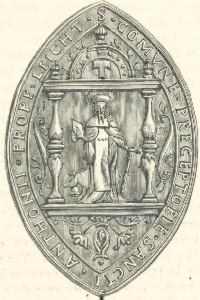|
THE
HISTORY OF LEITH |
||
|
Among my Masonic illustrations I have many definitions of the Tau. Some being that it means T.H. or Templum Hierosolyma, Temple of Jerusalem; or that it means a treasure, or a place were treasure is buried. The Tau is a figure constructed of five lines and is considered an important emblem or badge in Royal arch Masonry. There is also a triple cross like a T of the Egyptian, Roman, or English Alphabet. What is the connection to Leith? This symbol was the symbol of the Knight Templars of St Anthony of Leith. Their Church, burying place with gardens were in St Anthony’s Wynd-an ally off the Kirkgate which no longer exists. Their Preceptory however lay in the area running from the Kirkgate Shopping Centre and Community Centre to Yardheads (Yard in Yardheads incidentally comes from Old High German Yarde meaning a Monastic garth or wall) and Henderson Gardens. Evidence for this comes from a Charter of King James VI which says All the Croft of Arable land contiguous to St Anthony’s garden, and also all that place and piece of ground whereon the Church and Preceptory of St Anthony of the Knights Templar stood”, which during the Siege of Leith bore the same name, in common with property I most parishes in Scotland which was held by the Knights Templar. Some houses in Edinburgh and Leith bore the Badge of the Order, a Tau Cross with the motto Lavs Deo” to show that they held the Superiority, but not, as is generally supposed indicating that they themselves occupied the premises. Further evidence was found in the last century when gas mains were being installed in St Anthony Street and substantial amounts of human remains were discovered. What they had found was the graveyard of the Preceptory of St Anthony. This graveyard was quite substantial covering much of what is St Anthony and Great Junction Street to the Foot of Leith Walk. When the New Kirkgate shopping Centre was built further human remains were found. The church or monastery was very large, approximately 325 feet in length from east to west. It appears to have had a double Nave similar to the Templar Church at Templecombe in England with a large central steeple. The evidence for this comes from two sources. First from sir Thomas Fisher in a letter to Somerset, Lord Protector of England, dated 11th October 1548 means a substantial Church in the area. Secondly, from the Siege of Leith when French Gunners mounted their cannon within the Tower. However. Within a few hours the Tower was demolished by English cannon fire. At this stage it is important to clear up an important point. According to many writers Leith was a very poor place during the middle ages. This was not true. When Lord Somerset entered Leith during what was called the Rough Wooing in 1544 Leith was found to be extremely wealthy: just as wealthy as London if not more so. This wealth came from the export of Wool to the Low Countries after the English flattened Berwick in 1296 under Edward I. This lead to the development of Leith into the Principal Port of Scotland until the rise of Glasgow in the 18th century. The wool came from the Border Abbeys of Melrose and Kelso who along with Dunfermline owned most of Leith and all the land from Melrose and Kelso to the Forth. They paid no taxes to the exchequer. The Church grow rich and so did Leith. This explains how such a large Church as the Preceptory of St Anthony could have been built and why many famous people in Scottish History came here. |
||
|
|
||
